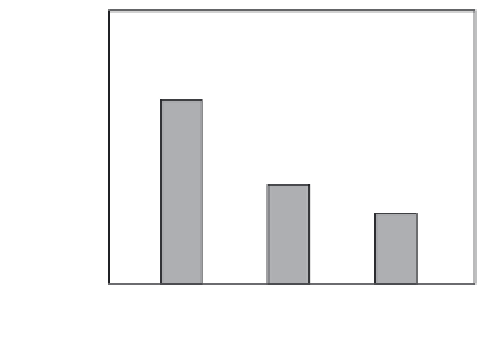Environmental Engineering Reference
In-Depth Information
persistent clear-water patches due to the development
of
Chara
meadows. Fourthly, both denitrification in
the macrophyte beds (Meijer
et al.
1994b) and the
release of allelopathic substances by macrophytes can
adversely affect phytoplankton (Fig. 12.10). The mech-
anisms for these negative feedbacks are, however, as
yet unclear (van Donk & van de Bund 2002).
The nuisance aspects of prolific macrophyte devel-
opment in restored lakes for recreation, for example
in Lake Veluwe (Hosper 1997), need further invest-
igation. Removal of plants by harvesting is a common
practice in ditches and canals in Europe. Harvesting
in such cases is a sequel to lake restoration rather than
a restoration technique in itself: it does, however, imply
a net export of nutrients from the lake ecosystems
so that its long-term, positive effects on the restored
system cannot be disregarded.
25
a
20
15
b
10
b
5
0
Cyanobacteria
Other phyto-
plankton
Detritus
Fig. 12.11
Clearance rates of adult zebra mussel
(
Dreissena
) on different food particles from Lake
Zwemlust, the Netherlands. The clearance rates on
cyanobacteria are significantly higher than those on
other phytoplankton and detritus as indicated by the
letters a and b above the bars (
P
> 0.05; Tukey's test).
From Dionisio Pires
et al.
(2004). Reproduced by
permission of Blackwell Publishing.
Role of zooplankton
Gulati and van Donk (2002) stressed the importance
of fundamental research on zooplankton dynamics and
zooplankton grazing activities for their application in
lake biomanipulation (see Gulati 1990a, 1990b, 1995,
Gulati
et al.
1992). Manipulation of fish communities
for lake restoration has the main objective of devel-
oping populations of large-bodied
Daphnia
to increase
grazing pressure on algae (Moss 1998). In eutrophic
Danish lakes, Jeppesen
et al.
(1999) observed that
zooplankton grazing on phytoplankton caused clear-
water conditions in early summer. This led them to
hypothesize that the role of zooplankton grazing for
water clarity, especially in macrophyte-rich lakes,
may increase with increasing lake trophy. That the
marked increase in larger-bodied daphnids and their
grazing pressure on phytoplankton following reduc-
tion of the planktivorous fish causes clear-water
conditions has been reported from several lakes in
western Europe (e.g. Timms & Moss 1984, Gulati
1990a, 1990b, Søndergaard
et al.
1990, Hosper 1997,
Meijer 2000). The prospects of such a clear-water
phase can be predicted from net losses of lake seston
(phytoplankton and detritus) due to grazing, using
regressions of animal length versus filtering rate,
grazer densities and seston concentration (Gulati
1990a, 1990b, Gulati
et al.
1992). Since larger-bodied
cladocerans (
Daphnia
spp.) are superior competitors for
food compared with rotifers, if fish predation is low
it is important that conditions for
Daphnia
growth and
development are stimulated to inflict greater mortal-
ity on phytoplankton (Gulati 1990b).
Role of the zebra mussel
The zebra mussel,
Dreissena polymorpha
, a bio-
invader in many lakes, is a potential tool for lake
management. Exploratory works in the Netherlands
(Reeders & bij de Vaate 1990, 1992, Noordhuis
et al.
1992) formed the basis for studies by Dionisio Pires
et al.
(2004). They demonstrated that adult mussels
showed higher clearance rates on cyanobacteria than
on other phytoplankters and detritus (Fig. 12.11). In
Lakes IJssel and Veluwe and other Border Lakes, the
areas colonized by zebra mussels are observably
clearer than other lake parts (Harry Hosper, personal
communication). However, we know little about the
sudden disappearance
en masse
of these mussels from
lakes. Both lack of suitable substratum and lake
eutrophication are plausible causes for the inability of
the mussels to establish and build up large popula-
tions in these lakes. That the macrophytes form a










